Confronting the Modern Era
Music
Music has always been an important part of Tennessee’s heritage. It was played and sung by the first settlers, children, families in their homes, Civil War soldiers, and performers on the stage.
With the new technology in the late 1800s and early 1900s, uniquely Tennessee music could be shared with the nation. Both country music and blues, developed in the state, gained national acclaim.
By the 1920s Tennesseans could purchase a Victor radio, or Victrolas, in order to play records and listen to radio broadcasts. Music performed by bands and orchestras were popular.
Listen to this 1917 performance of "Stars and Stripes Forever March" by The Sousa Band, led by famed leader John Philip Sousa.
Country Music
Country music performers such as Charlie Oaks, George Reneau, and Uncle Dave Macon had earned a modest living by traveling and performing their songs across the South.
Listen to this 1917 performance of "Stars and Stripes Forever March" by The Sousa Band, led by famed leader John Philip Sousa.
http://tn4me.org/audio/Stars-Stripes-Forever.mp3
Country music performers such as Charlie Oaks, George Reneau, and Uncle Dave Macon had earned a modest living by traveling and performing their songs across the South.
However, Nashville’s first radio station, WSM, helped to spread the music to millions across the country. This small station was one of the most powerful in the country, claiming some 1,000 watts of power, which allowed it to be heard hundreds of miles away.
George Hay , a Memphis native, was one of the first announcers on the station, and promoted local talent. In 1925, Uncle Jimmy Thompson, a well-known local fiddler, was a huge success performing live on the station. Letters came from across the country, praising the fiddler and requesting his songs be played more.
Uncle Dave Macon joined WSM in 1926 as its first singer. He would sing, play the banjo, and then tell jokes. He was an immediate hit as working people identified with his songs. To learn more about Uncle Dave Macon, click here.
Bristol Sessions
The defining moment in the birth of country music came in the summer of 1927 when 19 bands gathered for recording sessions in Bristol, Tennessee.
Ralph Peer with Victor Recording Company had placed ads in local newspapers inviting local talent to come and perform. News articles pointing out that Ernest Stoneman had received $3,600 in royalties from his records in 1926 probably encouraged singers to come.
Ralph Peer with Victor Recording Company had placed ads in local newspapers inviting local talent to come and perform. News articles pointing out that Ernest Stoneman had received $3,600 in royalties from his records in 1926 probably encouraged singers to come.
Some of those recorded in Bristol went on to become the biggest stars in the music field. The recording sessions would be known as the “Bristol Sessions.” Jimmie Rogers recorded two songs including one with what would become his trademark yodeling. Rogers was later honored as the Father of Country Music or “the man who started it all.”
Another group, the Carter Family, began their long career in country music at Bristol. A.P. Carter along with his wife, Sara, and Sara’s cousin, Maybelle, recorded several records. Peer said, “They looked like hillbillies. But as soon as I heard Sara’s voice, that was it. I knew it was going to be wonderful.” Listen to the Carter Family's performance of "Bury Me Under the Weeping Willow." The Carter Family recorded this song at Bristol, however, this may not be that version.
http://tn4me.org/audio/BuryMeUnderTheWeepingWillow.mp3
In 1925 Hay began the “Barn Dance” radio program which later was renamed the Grand Ole Opry. It quickly became a sensation among rural Americans, and it benefited musicians. Being paid as much as ten to fifteen dollars a night allowed many talented Tennesseans to become professionals. Their music continued to grow in popularity across the country.
Deford Bailey of Smith County, Tennessee, was an African American harmonica and guitar player who became a popular figure on the show. Originally dis-cover-ed while working as an elevator operator in the company building, he appeared on the show more times than any other performer during his 20-year career. To learn more about Deford Bailey, click here.
Although some contemporary Tennesseans disapproved of the “hillbilly music” image that the Grand Ole Opry portrayed, Nashville nevertheless became the early home of country music. It is still considered the home of country music today.
Blues
Blues was another form of music which gained popularity during this time. The blues developed in the Mississippi Delta and in Memphis. Memphis blues singers were more into the popular trends including jug band s. Read more about Memphis jug bands.
Blues music had its beginnings in other types of black music including gospels, African songs, and spirituals. W.C. Handy said the “blues were conceived in aching hearts.” African Americans sang the blues when they were working, when they were relaxing, and just about any other time.
Tennesseans such as Bessie Smith of Chattanooga and Alberta Hunter of Memphis became national celebrities as blues music gained wide appeal among both northern and southern music listeners.
By 1923 Smith had sold over two million records, while Hunter’s classic “Down Hearted Blues” became one of the biggest selling albums of the decade. Hunter, who was born on Beale Street, was a top recording and stage star. The music of "Down Hearted Blues" was written by another Tennessee woman, Lovie Austin, who was also a renowned pianist.
Smith’s powerful and passionate singing earned her the title “Empress of the Blues,” and helped popularize the music in northern urban areas as well as in the South. Although a singer, she also became a symbol of African American resistance, women’s rights, and the plight of the poor in the South during the Jim Crow Era. Click here to read more about Bessie Smith.
Ida Cox of Knoxville was a composer and singer during this time as was Lillian Hardin who was born in Memphis and educated at Fisk University.
W. C. Handy also helped popularize the blues, a feat that would help to earn him the title “Father of the Blues.” An accomplished musician, Handy had visited Memphis many times, but finally decided to move to the city in 1907 in order to further his music career.
His first published work, Memphis Blues, was an overwhelming hit, and helped define the blues as a musical genre. His biggest hit by far, however, was St. Louis Blues, released in 1914. Listen to the St. Louis Blues recorded by W.C. Handy's Memphis Blues Band.
Smith’s powerful and passionate singing earned her the title “Empress of the Blues,” and helped popularize the music in northern urban areas as well as in the South. Although a singer, she also became a symbol of African American resistance, women’s rights, and the plight of the poor in the South during the Jim Crow Era. Click here to read more about Bessie Smith.
Ida Cox of Knoxville was a composer and singer during this time as was Lillian Hardin who was born in Memphis and educated at Fisk University.
W. C. Handy also helped popularize the blues, a feat that would help to earn him the title “Father of the Blues.” An accomplished musician, Handy had visited Memphis many times, but finally decided to move to the city in 1907 in order to further his music career.
His first published work, Memphis Blues, was an overwhelming hit, and helped define the blues as a musical genre. His biggest hit by far, however, was St. Louis Blues, released in 1914. Listen to the St. Louis Blues recorded by W.C. Handy's Memphis Blues Band.
http://tn4me.org/audio/St.LouisBlues.mp3
Handy opened a music publishing company on Beale Street. His orchestra from Memphis recorded for Columbia Records in New York City. For more information about W.C. Handy, click here.
Thanks in part to Handy and others such as Furry Lewis, Memphis Minnie, Fiddling Abe Fortas, and Sleepy John Estes, Memphis became internationally known as the Home of the Blues.
Gospel
Another popular type of music in Tennessee that was gaining national attention was gospel music. In some ways, gospel music was the religious version of country and blues music. Hymns were played in churches and revivals across the state. They had been adapted to include the instruments, melodies, tones, and counts characteristic of these other two Tennessee musical traditions. Listen to a well-known gospel song titled "Will the Circle Be Unbroken?" It was recorded by the Carter Family.
http://tn4me.org/audio/CanTheCircleBeUnbroken.mp3
Many southern artists of other genres recorded gospel songs or albums. Gospel quartets also became popular. James Vaughn of Lawrenceburg, Tennessee, helped make gospel music popular. He published over one hundred song books in his lifetime, many of which included the original works of amateur artists across the south. In the 1920s he also opened a music school, a radio station, and a recording studio in Lawrenceburg to promote gospel music and spread its commercial appeal nationally.
Opera
Classical and operatic music was still very popular during this period. One of the better known stars was Grace Moore from Cocke County. She studied music at Ward-Belmont College in Nashville and later in Washington and New York City.
She appeared in musical comedies and made her Metropolitan Opera debut in 1928. She started making movies in Hollywood. Her greatest success was the movie “One Night of Love” in 1934. Moore continued performing in operas and concerts. She was at the height of her fame when she died in an airplane crash in Denmark in 1947.
Picture Credits:
- Photograph showing Daniel Beeler playing music at Sharp’s Chapel. Beeler is playing the banjo and is accompanied by a man playing the violin. This photo was taken in 1912 in Union County, Tennessee. Tennessee State Library and Archives.
- Photograph of the First Orchestra of Knoxville College. This photo was taken in 1887in Knoxville. It shows six young men posing with their instruments on the steps outside of a building. Three women can also be seen standing in the doorway. Tennessee State Museum Collection.
- Photograph of two musicians. This photo was taken sometime between 1920 – 1930 in east Tennessee. It shows Glenn Ledbetter and Russell Whitehead playing the banjo and guitar. University of Tennessee.
- Photograph entitled, “Three man band.” This photo was taken in 1890-1903. It shows three African American men standing and holding musical instruments: a tuba, a guitar, and a fiddle. Blount County Public Library.
- Photograph of W. C. Handy’s band. This photo was taken in Memphis and is dated June 18, 1918. It shows Handy holding a trumpet along with six other musicians in his band holding their instruments. University of Memphis.
- Photograph showing two women playing instruments. This photo was taken sometime between 1900 – 1920 in East Tennessee. Two women are shown playing a violin and a banjo. Two young girls and two older women are also shown sitting nearby. University of Tennessee.
- Photograph of Saffer’s Orchestra. This photo was taken in 1901 in Chattanooga. Saffer’s orchestra was the leading orchestra from 1900-1915. Saffer is shown standing third from the left. Chattanooga Hamilton County Bicentennial Library.
- Photograph of the Canon Jug Stompers. It features Gus Cannon, Ashley Thomson, and Noah Lewis. Tennessee State Museum Collection.
- Photograph of Jimmie Rodgers and the Carter Family. This photo was taken in 1931. Rodgers in shown dressed in white standing on the left and the Carter family on the right. Birthplace of Country Music Association.
Photos Attached to Names Credits
- Photograph of W. C. Handy. This photo was taken in 1926. It show Handy holding his recently published work, Blues: An Anthology. University of Alabama.
- Photograph of early country music singer, Deford Bailey. Tennessee State University.
- Photograph of George Hay, founder of WSM “Grand Ole Opry.” Country Music Planet.
- Photograph of gospel music publisher, James Vaughn. James D. Vaughn Museum.
- Photograph of singer Grace Moore. This photo was taken in 1933 by Carl Van Vechten. Library of Congress.
- Photograph of blues singer Alberta Hunter. The African American Registry.
Confronting the Modern Era >> Life in Tennessee >> How They Lived >> Music
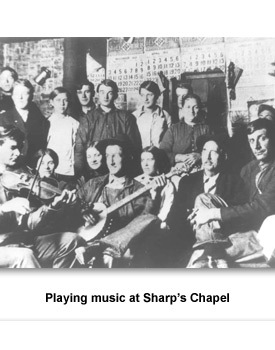
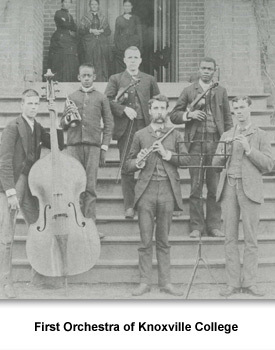
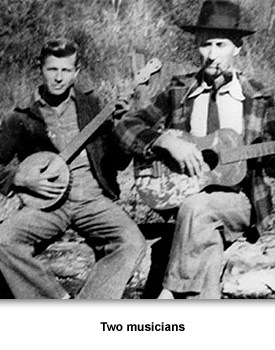
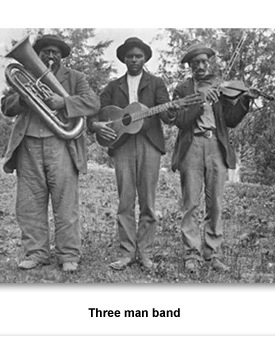
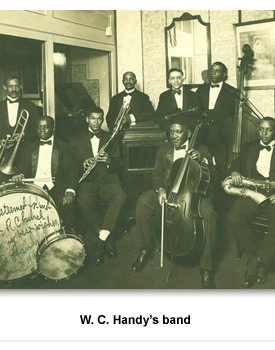
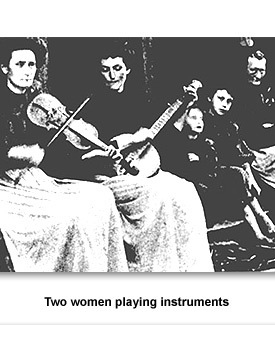
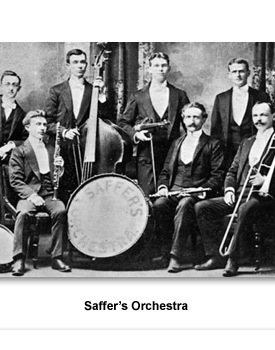
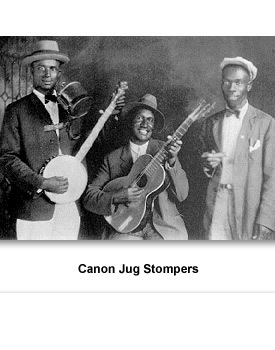
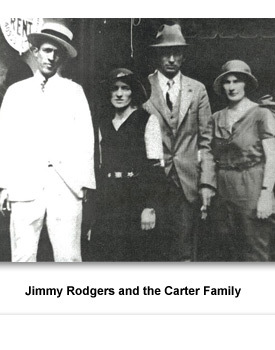
 Sponsored by: National Endowment for the Humanities
Sponsored by: National Endowment for the Humanities